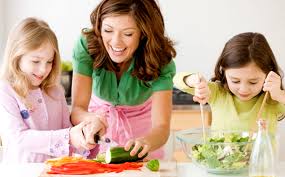Nurturing Natural Healthy Eaters
By Indra Balaratnam, Consultant Dietitian
Children’s nutrition status is one of the main factors doctors look at to determine their proper growth and development. Studies show that children who get sufficient nutrition are better able to reach their growth potential in height and weight; whereas those that are undernourished tend to be stunted in growth. A trend that is becoming a global problem now is children overeating and becoming obese or overweight.
There’s no denying that nutrition is an extension of parenting skills. This means, parents need to help children learn how to make sensible food choices and this must be cultivated from a young age. Otherwise, it is going to be a huge challenge to get them to eat healthy when they reach their teens.
What are the best ways to help children eat healthily in a natural way? It’s really not rocket science. In fact, it’s actually simpler than you think. Here are some great ways :
Be a Positive Role Model
Children imitate and copy what the people dearest to them do. So if you want your child to eat healthier, you should do the same too. “My daughter likes carbonated sodas,” lamented a mother of a child client of mine at one of our sessions. Upon further probing, I found out that the parents often drink sodas too! Another friend of mine kept making comments that his 10-year-old son never eats vegetables. When I observed my friend’s family, I could clearly see why. All the meals they ate hardly have any substantial servings of vegetables. How could you expect a kid to like vegetables when he hardly gets to taste any?
Keep in mind that natural healthy eating habits cannot be forced upon. They must be positively influenced – and you, as the parent or caregiver are the most influential of all.
Tips to be a better role model:
- Read up on nutrition from health magazines, books or websites. The more you know the better you understand.
- Attend nutrition talks or public nutrition events. Newspapers would usually have community announcements of such events hosted by hospitals or organisations.
 Let Children See where Food Comes From
Let Children See where Food Comes From
When I was growing up, my mum took me to the wet market most Saturday mornings. The sights and sounds of the wet market still linger in my memory. I’ll never forget seeing chunks of meat up on a hook, an array of fresh fishes and seafoods on a bed of ice, an assortment of colourful vegetables and fruits, fresh coconuts being scraped with a machine as well as large open sacks of lentils and beans. Whenever she chose her shopping items, my mum would make me do so too. She would teach me how to see if the fish was fresh by looking at the gills, or how to determine if the ladies’ fingers were old by snapping the tips off. All these things had a lasting impact on me. It made me appreciate buying wholesome produce for my family’s meals. When a child sees the trouble you go through to purchase these fresh produce, they will inevitably see that mealtimes are important.
Of course, in this day and age, many urbanites do their marketing in hypermarkets or supermarkets (or some at the pasar malam after work). Wherever it is you shop for food, the experience of doing it with your child still remains extremely valuable and significant in influencing their healthy eating habits.
Tips to empower your child to help shop for food:
- I know sometimes running errands with children can be bothersome, but do make more effort to include them whenever you can. The experience in itself is 10,000 times better than just preaching about nutrition to them. Remember, people learn much better visually than just by listening alone.
- Involve your child in making decisions. This makes them feel important. One way to do this is to say, “We need some fruits this week. Let’s choose two types of fruits. What fruit do you think we should buy for the family?” If you have more than one child, let each child make a suggestion.
- Let them help in selecting the produce. This simple task is very empowering for a child. Give him a little guidance; for example, avoiding vegetables that are bruised. But after that, stand back and let them do the choosing. A client of mine who did this with her child was amazed that during meal time, the child ate the vegetable as well – something of a rarity as her child often refused to eat her veges. The child beamingly told the family at the dining table, “I chose this carrot!”
Let Them Be Your Chef Assistant
Do let your child help you with the cooking by giving them something to do that is age appropriate. Smaller kids will be able to help peel vegetable leaves or butter up bread; while the older ones can probably help with cutting or breaking eggs. Being part of cooking the meal is an extension of the empowering feeling they get, similar to helping purchase the groceries. It saddens me to see that in many households that have maids, the children don’t have the opportunity to do these kinds of chores anymore. Even if your maid does the cooking, I would encourage you to allow your child to help as well.
Tips to let children assist in cooking:
- While cooking, this is a good time to explain to your little one the goodness in the foods he is cooking. For example, you can tell them that meat is a good source of protein to help them grow or those vegetables they are peeling contains vitamins to keep their body strong against germs.
- Children’s attention span is short. It’s ok if they don’t want to stay in the kitchen until you finish cooking. Believe me, that few precious minutes have a lasting impact on nutrition.










